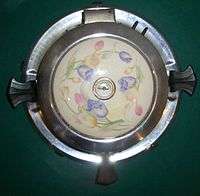Waffle iron


A waffle iron is a utensil or appliance used to cook waffles. It usually consists of two hinged metal plates, molded to create the honeycomb pattern found on waffles. The iron is heated and either batter is poured or dough is placed between the plates, which are then closed to bake the waffle.
Varieties
Traditional waffle irons are attached to tongs with wooden handles and are held over an open flame, or set on a stove. Most modern waffle irons are self-contained tabletop electrical appliances, heated by an electric heating element controlled by an internal thermostat. Professional waffle makers are usually made of cast-iron whereas domestic models are often teflon coated. Many have a light that goes off when the iron is at the set temperature. Most modern waffle irons - particularly cast aluminum ones - are coated with a non-stick coating (e.g. teflon) to prevent the waffles from sticking to them. Cast iron waffle makers are usually not coated and require seasoning like a cast iron frying pan.
Modern waffle iron makers offer a large variety of choices. Some waffle irons can make a very thin waffle, capable of making waffle cones or Pizzelle. While there is no set standard of classification for waffle shapes or thicknesses, models that fall within the most common shapes and thicknesses are often labeled as "traditional" or "classic". Models that make thicker and/or larger pocketed waffles are often labeled as "Belgian" waffle makers. In the USA, the most commonly used determining factor of whether a waffle is a "Belgian waffle" or not is the thickness and/or pocket size, although the recipes for Belgian waffles and American waffles do differ.
History
The earliest waffle irons originated in the Low Countries around the 14th century.[1] These waffle irons were constructed of two hinged iron plates connected to two long, wooden handles. The plates were often made to imprint elaborate patterns on the waffle, including coat of arms, landscapes, or religious symbols. The waffles would be baked over the hearth fire.
In 1869, American Cornelius Swarthout (also spelled as Swartwout) patented the first U.S. waffle iron. This iron sat atop wood or gas stoves. The cast iron plates were joined by a hinge that swiveled in a cast iron collar.[2][3][4] In 1891 John Kleimbach, a German immigrant living in Shamokin, Pennsylvania became a traveling salesman of waffles after fashioning an iron for the Mansion House Hotel. Kliembach sold waffles for a penny each or ten cents for a dozen.[5] He was a sensation at the Chicago World's Fair.
In 1911, General Electric produced a prototype electric waffle iron, although production did not begin until around 1918.[5] Later, as the waffle iron became more prevalent, designers worked on making the appliance more attractive on the countertop.
Other uses
In 1971, Oregon track coach and Nike Co-founder Bill Bowerman used his wife's waffle iron to experiment with the idea of using waffle-ironed rubber to create a new sole for footwear that would grip but be lightweight. Bowerman's design inspiration led to the introduction of the so-called "Moon Shoe" in 1972, so named because the waffle tread was said to resemble the footprints left by astronauts on the moon. Further refinement resulted in the "Waffle Trainer" in 1974, which helped fuel the explosive growth of Blue Ribbon Sports/Nike.[6][7]
Gallery
-
A waffle iron in the shape of Texas
-

1940s ElectraHot (Minneapolis, MN) waffle iron with a Hall China insert
-
Waffle iron with logo of Country Inns & Suites, advertising the company logo on waffles made by customers.
See also
| Wikimedia Commons has media related to Waffle irons. |
- Brown Bobby, a triangular American donut made in a waffle iron like machine
- Krampouz, a French manufacturer of small cooking appliances
- List of cooking appliances
- Pancake machine
- Sandwich toaster, various machines, often waffle iron sized, that press and cook a filling between two slices of bread, to make a hot filled sandwich, with the edges sealed together
- Waffle
References
- ↑ Helene Siegel (1 September 1996). Totally pancakes and waffles cookbook. Random House Digital, Inc. ISBN 978-0-89087-804-0. Retrieved 1 November 2011.
- ↑ Marquis Who's Who Staff; Marquis Who's Who (1967). Who was who in America: a companion biographical reference work to Who's who in America. Marquis-Who's Who. p. 58. Retrieved 1 November 2011.
- ↑ Cornelius Swartwout Inventor of the Waffle Iron
- ↑ Cornelius Swartwout U.S. Patent 94,043 Waffle iron issued on August 24, 1869
- 1 2 George, William (2003). Antique Electric Waffle Irons 1900-1960: A History of the Appliance Industry in 20th Century America. Trafford Publishing. p. 13. (For the GE 1911 model description, p. 74, click here)
- ↑ Douglas Holt; Douglas Cameron (1 November 2010). Cultural Strategy: Using Innovative Ideologies to Build Breakthrough Brands. Oxford University Press. pp. 41–. ISBN 978-0-19-958740-7. Retrieved 1 November 2011.
- ↑ Jeroen Scheerder (2010). Vlaanderen loopt! Sociaal-wetenschappelijk onderzoek naar de loopsportmarkt. Academia Press. pp. 75–. ISBN 978-90-382-1484-9. Retrieved 1 November 2011.
External links
- What are pancakes and waffles?
- Food Timeline—history notes: waffles
- Theory and Technology of Waffles
| ||||||||||||||